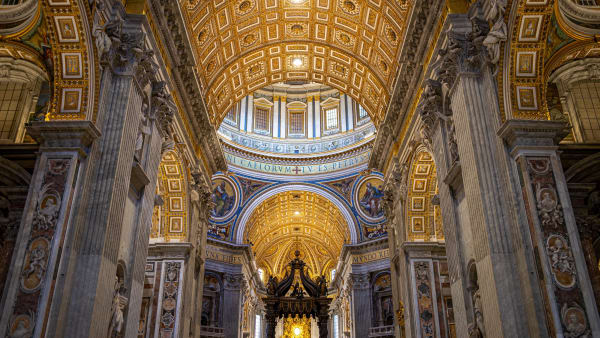Brief history
Brief history
The majestic appearance of the Pantheon has hardly changed in 2,000 years. The current complex was built between 118 and 125 AD by Emperor Hadrian and it largely replaced two older temples on the same site.
The first of which had been built about 150 years earlier by Marcus Vipsanio Agrippa (a Roman general, statesman, and architect) but was damaged by a fire in the year 80 AD. A second temple, built by Emperor Domitian, suffered a similar fate when it got struck by lightning in 110.
Republican period (509 - 27 BC)
The Pantheon was founded in 27 BC by Agrippa (a close friend, son-in-law, and lieutenant to Augustus) whose name is engraved on the facade. He wanted to have a temple built dedicated to all the gods. For this, he entrusted the execution to Lucio Cocceio Aucto, a famous Roman architect and engineer.
It’s said that the monument was constructed at Agrippa’s expense, on a piece of his property next to the Basilica of Neptune. The first version of the temple included a rectangular base, with a transverse cellae (the inner part of the structure), a pronaos (space in front of the cellae), and was built in marble-clad blocks facing south.
In front of the building was a circular plaza that separated the temple from the Basilica of Neptune. It was surrounded by a wall, with a floor of travertine slabs. Later, marble slabs were laid on top of this, probably during the restoration commissioned by Domitian.
Much of the information we have about this first version of the temple comes from Pliny the Elder (a Roman soldier, politician, and historian) who personally saw the structure and recorded his observations in his work Naturalis Historia.
Agrippa’s intention seems to have been to found a temple dedicated to the seven planetary deities. In particular to Mars and Venus, protectors of the gens Julia (an influential patrician family of ancient Rome). It also appears that he wanted to place a statue of Octavian Augustus in the temple, from whom the building would take its name.
Since Emperor Augustus didn’t agree with either proposal, Agrippa had a statue of Divus Julius (the deified Caesar) built inside and one of Octavian and one of himself in the pronaos, in memory of their friendship and commitment to the common good.
Imperial Period (27 BC - 476 AD)
After the fires of 80 and 110 AD damaged the first structure, several restoration attempts were made by Domitian and Trajan. Until the period from 120 to 124 AD, Emperor Hadrian had the Pantheon rebuilt.
It appears that the second version of the temple was the work of architect Apollodorus of Damascus. Based on the timing and characteristics of the building, it’s also possible that Trajan had already started the rebuilding. And that after his death, Hadrian resumed the work after a period of interruption. What we do know is that the temple was completed with some modifications to the original design.
The final version of the Pantheon has a circular shape and is connected to a portico of Corinthian columns (eight in the front row and two groups of four in the second and third rows), supporting a triangular pediment. Despite the reconstruction, the original inscription of the building has been preserved.
The large circular cell, known as the Rotunda, is surrounded by thick walls of masonry and eight large columns on which the weight of the characteristic concrete dome is distributed. In the semicircular dome, there is a circular opening at the top, called the Oculus, through which the interior is illuminated. The height of the building is equal to the diameter of the Rotunda, a feature that reflects the classical criteria of balanced and harmonious architecture.
Almost two millennia after its construction, the dome of the Pantheon remains one of the largest in the world and, in particular, the largest dome built in unreinforced concrete. It has a diameter of 43.3 m and is decorated inside with five orders of twenty-eight arches, decreasing in size as it increases in height.
Medieval era (476 - 1492)
The subsequent history of the temple is interesting and rich in events. After several restorations, both by Emperor Antonino Pio and at the beginning of the III century AD by Settimio Severo, the Pantheon fell into a state of abandonment.
The sharp demographic shrinkage in the Middle Ages meant that the population could only occupy a fraction of the ancient Roman cities, leaving many landscapes of ruins. This promoted the phenomenon of utilitarian reuse, which aimed to save time and manpower by using elements already worked on or buildings that still existed. The Forum Romanum, for example, then became a source of material for new buildings.
In 608, the Byzantine Emperor Foca gifted the church to Pope Boniface IV, who made it a Christian church under the name of Sancta Maria ad Martyres in 609. This is also the reason why the building has remained in continuous use and so well maintained that it’s still standing.
In the early days of Christianity, the Church Fathers encouraged the destruction of pagan temples. The Pantheon was transformed into a Christian church, marking the definite dominance of Christianity over pagan religions.
Renaissance (1492 - 1789)
As a holy church, the Pantheon and its surroundings must have been influenced by the will of the various popes who succeeded each other. The vicissitudes of the church in the following centuries deserve to be highlighted.
In 1600, the structure of the Pantheon was enriched with two bell towers on its façade, which were intended to give it a more ecclesiastical appearance. The towers weren’t appreciated by everyone and were soon nicknamed “donkey ears”. Eventually, they were removed in the 19th century.
In 1662 Alexander VII had some of the houses leaning against the church demolished. Clement IX in 1668 enclosed the portico with gates, which were later removed. In 1747, Benedict XIV ordered the restoration of the cellae. In the meantime, from the 15th century, the Pantheon was decorated with various paintings and busts of famous Romans, which Pius VII then had removed and transferred to the Campidoglio.
In 1625, Pope Urban VIII Barberini ordered to melt down several bronze decorations from the Pantheon. His intention was to use this material for a new canopy over the tomb of Peter in St. Peter’s Basilica. This was considered a major scandal and led to the famous statement “quod non fecerunt barbari, fecerunt Barberini” (“What the barbarians didn’t do, the Barberini did”). Some of the bronze was also used to craft 80 cannons for the papal fortress Castel Sant’Angelo.
Another noteworthy fact is that the Pantheon was used to bury famous people from the Renaissance onward, as explained in this section. Moreover, a link between the work and the arts was established and consolidated.
This was confirmed as early as 1542 when the Congregation of the Virtuous was founded in the Pantheon. This later grew into the Pontifical Academy of Fine Arts and Literature, transforming the building into a kind of art gallery until the end of the 19th century.
Contemporary times (1789 - present)
Today, the Pantheon is still in use as a Roman Catholic church. In this spectacular place that exudes centuries of history, masses are held and numerous weddings are performed, among other things. You can also attend special celebrations, such as the rain of rose petals.
The Pantheon is state-owned and since December 2014 it has been managed by the Ministry of Heritage and Cultural Activities. In 2019, it registered nearly 9 million visitors, making it the most visited Italian landmark.
In a nutshell, the Pantheon, one of the best-preserved monuments of Roman architecture, still can emotionally touch everyone who enters it by its grandeur, elegance, and harmony.















